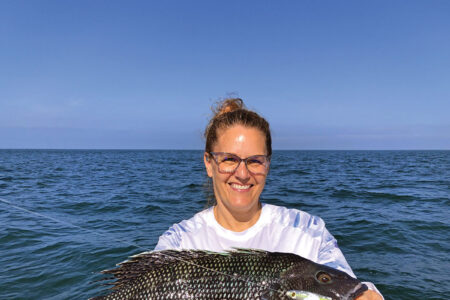
Use larger jigs to cull out the biggest sea bass of the pack.
Black sea bass are excellent sportfish because they’re opportunistic feeders, strike aggressively, and fight hard all the way to the surface. Their varied diet includes baitfish like herring, sand eels, peanut bunker, baby butterfish, juvenile porgies, and squid, which is why diamond-style metal jigs work so well.
“Almost any deep structure from eastern Long Island Sound through New York, Rhode Island, and southern Massachusetts is a potential sea bass jackpot,” says Capt. ‘Q’ Kresser. “Sharpies closely guard their hotspots because a fleet of boats on a patch of ground can pick it clean of big fish. But there are hundreds of productive spots in New England, and many are seldom fished. Your best bet is to study a chart and your depthfinder to locate and mark your own sea bass hangouts. Don’t just follow the fleet.”
Experienced fishermen agree that diamond and Norwegian jigs often outfish standard bait rigs for the biggest bass by keeping shorts and pesky porgies at bay, which can pick a high/low bait rig clean in seconds. But many experts enhance their odds by tying in a dropper teaser above the jig consisting of a pink or white bucktail-dressed hook or soft plastic squid imitation.
“I personally don’t use bait anymore,” says Capt. Ned Kittredge of Westport, Massachusetts. “Sea bass are hungry and aggressive. I’d rather not deal with bait and shorts if I don’t have to. Sometimes I fish with just a metal jig, but if the fish are thick or suspended just above the structure, a teaser is a good idea. I find that sea bass will strike the jig more often, but they do hit the teaser, and sometimes you’ll land a double.
“Whatever size hooks are factory installed are sufficient, they’re not worth changing out for sea bass, but I prefer treble over single hooks if the bottom isn’t too rough and unforgiving or I’m not among lobster gear.”
When using metals for sea bass, a 3- to 4-ounce jig performs best because its size most closely mimics their forage. Tie a 3-foot section of 30- to 40-pound monofilament line as abrasion leader, and attach it to braided main line for reduced current drag. Attach the jig to the leader with a loop knot to enhance its action.
Anglers often tip jig or teaser hooks with a small squid strip—small so as not to impair the jig’s drop speed or action—but when the bite is red-hot naked metal lures perform well. Small jigs don’t succeed in water deeper than 100 feet or when the current is ripping because they won’t fish vertically. Some diamonds heavy enough to maintain bottom in those situations are too large for average sea bass, so restrict your jig weight to 8 ounces or less during challenging conditions.
There are many ways to work a diamond jig, depending on the species you’re targeting, but for sea bass, bluefish-style speed-jigging isn’t the most productive method because you’re constantly retrieving your jig out of the sweet spot. Also not effective is the “swing-for-the-fences” approach with long and fast upward rod sweeps—good for stripers or cod—but not for sea bass.
The right technique is subtler, keeping the metal bouncing right along the bottom, as if tending a sinker, but using short 12- to 18-inch strokes by snapping the rod tip up and allowing a fluttering motion just off the bottom on the fall. Expect to hang up occasionally, and maybe lose a lure, but it’s well worth the reward.
“It’s important to keep your jig near the bottom,” says Kittredge, “or no more than a ‘rod-tip’ off the bottom, imparting a short-but-exact and fairly swift jigging motion. These fish prefer structure, and rarely venture too far up to feed. Drop it quickly but don’t lose complete contact with the jig, as the strike often comes on the way down. It requires practice and touch to be successful.”
Tackle selection, like jig size, is determined by the waters and conditions you expect, as you can target sea bass in depths of 30 to 120 feet from spring through early autumn.
“I jig sea bass with lighter gear than most people,” says Kittredge, “I can fish all day with such a set up, and still land the occasional striped bass or bluefish that falls for the diamond, which perfectly imitates local prey species.”
For a multipurpose outfit in shallow water, try a conventional 6-1/2- to 7-foot moderate-action rod (a moderate action assists with the “snapping” motion) in the 12- to 25-pound range matched with a 2/0-3/0 conventional level-wind reel like a Shimano Tekota 500. Spool it up with 17- to 20-pound braid topshot over 30- to 40-pound mono backing. And then hang on for some great sport and good eating.



